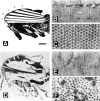Specific myosin heavy chain mutations suppress troponin I defects in Drosophila muscles
- PMID: 10085296
- PMCID: PMC2148188
- DOI: 10.1083/jcb.144.5.989
Specific myosin heavy chain mutations suppress troponin I defects in Drosophila muscles
Abstract
We show that specific mutations in the head of the thick filament molecule myosin heavy chain prevent a degenerative muscle syndrome resulting from the hdp2 mutation in the thin filament protein troponin I. One mutation deletes eight residues from the actin binding loop of myosin, while a second affects a residue at the base of this loop. Two other mutations affect amino acids near the site of nucleotide entry and exit in the motor domain. We document the degree of phenotypic rescue each suppressor permits and show that other point mutations in myosin, as well as null mutations, fail to suppress the hdp2 phenotype. We discuss mechanisms by which the hdp2 phenotypes are suppressed and conclude that the specific residues we identified in myosin are important in regulating thick and thin filament interactions. This in vivo approach to dissecting the contractile cycle defines novel molecular processes that may be difficult to uncover by biochemical and structural analysis. Our study illustrates how expression of genetic defects are dependent upon genetic background, and therefore could have implications for understanding gene interactions in human disease.
Figures






Similar articles
-
Myosin rod protein: a novel thick filament component of Drosophila muscle.J Mol Biol. 1997 Jan 10;265(1):40-55. doi: 10.1006/jmbi.1996.0710. J Mol Biol. 1997. PMID: 8995523
-
Suppression of muscle hypercontraction by mutations in the myosin heavy chain gene of Drosophila melanogaster.Genetics. 2003 May;164(1):209-22. doi: 10.1093/genetics/164.1.209. Genetics. 2003. PMID: 12750333 Free PMC article.
-
Determining structure/function relationships for sarcomeric myosin heavy chain by genetic and transgenic manipulation of Drosophila.Microsc Res Tech. 2000 Sep 15;50(6):430-42. doi: 10.1002/1097-0029(20000915)50:6<430::AID-JEMT2>3.0.CO;2-E. Microsc Res Tech. 2000. PMID: 10998634 Review.
-
Drosophila myosin mutants model the disparate severity of type 1 and type 2B distal arthrogryposis and indicate an enhanced actin affinity mechanism.Skelet Muscle. 2020 Aug 15;10(1):24. doi: 10.1186/s13395-020-00241-6. Skelet Muscle. 2020. PMID: 32799913 Free PMC article.
-
Properties of mutant contractile proteins that cause hypertrophic cardiomyopathy.Cardiovasc Res. 1999 Oct;44(1):20-36. doi: 10.1016/s0008-6363(99)00213-8. Cardiovasc Res. 1999. PMID: 10615387 Review.
Cited by
-
Mutual rescues between two dominant negative mutations in cardiac troponin I and cardiac troponin T.J Biol Chem. 2010 Sep 3;285(36):27806-16. doi: 10.1074/jbc.M110.137844. Epub 2010 Jun 15. J Biol Chem. 2010. PMID: 20551314 Free PMC article.
-
Transcription of Drosophila troponin I gene is regulated by two conserved, functionally identical, synergistic elements.Mol Biol Cell. 2004 Mar;15(3):1185-96. doi: 10.1091/mbc.e03-09-0663. Epub 2004 Jan 12. Mol Biol Cell. 2004. PMID: 14718563 Free PMC article.
-
Characterization of a hypercontraction-induced myopathy in Drosophila caused by mutations in Mhc.J Cell Biol. 2004 Mar 29;164(7):1045-54. doi: 10.1083/jcb.200308158. J Cell Biol. 2004. PMID: 15051736 Free PMC article.
-
Disruption of Caenorhabditis elegans muscle structure and function caused by mutation of troponin I.Biophys J. 2004 Feb;86(2):991-1001. doi: 10.1016/S0006-3495(04)74174-0. Biophys J. 2004. PMID: 14747334 Free PMC article.
-
Drosophila muscle regulation characterized by electron microscopy and three-dimensional reconstruction of thin filament mutants.Biophys J. 2004 Mar;86(3):1618-24. doi: 10.1016/S0006-3495(04)74229-0. Biophys J. 2004. PMID: 14990488 Free PMC article.
References
-
- al-Khayat HA, Yagi N, Squire JM. Structural changes in actin-tropomyosin during muscle regulation: computer modelling of low-angle X-ray diffraction data. J Mol Biol. 1995;252:611–632. - PubMed
-
- Bernstein SI, Milligan RA. Fine tuning a molecular motor: the location of alternative domains in the Drosophilamyosin head. J Mol Biol. 1997;271:1–6. - PubMed
-
- Collier VL, Kronert WA, O'Donnell PT, Edwards KA, Bernstein SI. Alternative myosin hinge regions are utilized in a tissue-specific fashion that correlates with muscle contraction speed. Genes Dev. 1990;4:885–895. - PubMed
Publication types
MeSH terms
Substances
Grants and funding
LinkOut - more resources
Full Text Sources
Molecular Biology Databases

